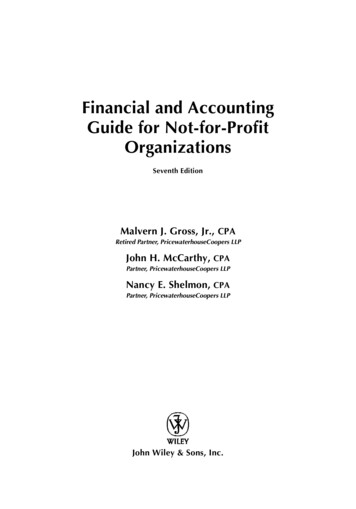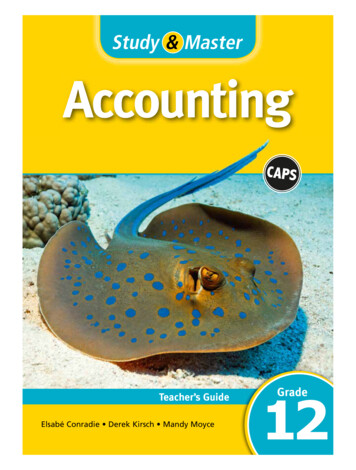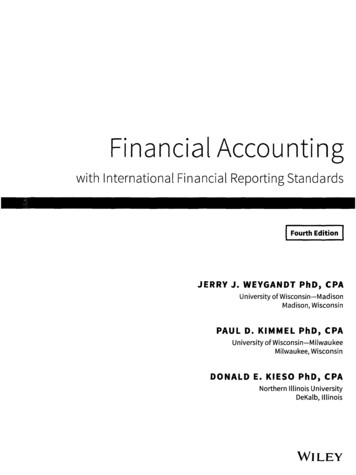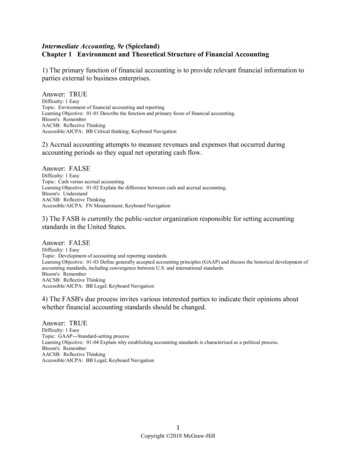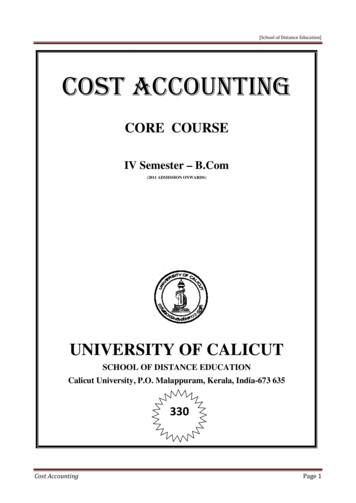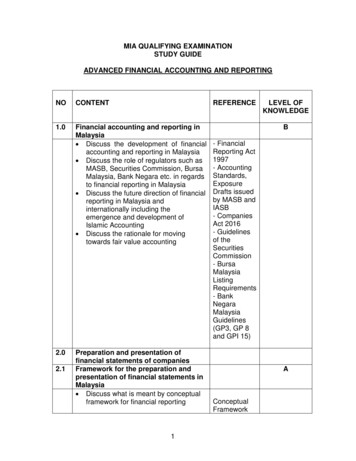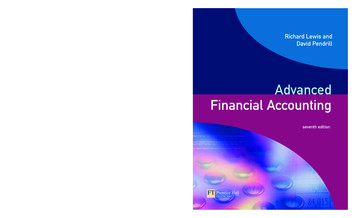
Transcription
Advanced Financial AccountingRichard Lewis and David PendrillRigorous in its approach, Advanced Financial Accountingtackles the more complex issues of the subject in a livelyand engaging manner. Familiar in its structure andtreatment of basic concepts, this seventh edition has beenthoroughly revised and updated to reflect recent andplanned developments in financial reporting.This leading text continues to provide both clearexplanations and critical evaluations of current accountingpractice, especially as found in national and internationalaccounting standards, and relates them to the needs ofusers of financial statements.The seventh edition is accompanied by a downloadableSolutions Manual which is available to lecturers on thewebsite at www.booksites.net/lewispendrill. As with theprevious edition, annual updates are also available online.Advanced Financial Accounting is written for second andthird year financial accounting students on accounting orbusiness studies degrees and is also suitable for MBAcourses. The book provides extensive coverage of thesyllabuses for the advanced papers in financial accountingand financial reporting of the ACCA, CIMA, ICAEW, ICAI andICAS.The new edition explains the considerable changes whichare scheduled to take place in the EuropeanUnion during the next few years examines the increasing importance of theIASB and international standards includes greater focus on internationaldevelopments provides in-depth discussion of allimportant areas, including controversialissues such as accounting for financialinstruments, goodwill and share options, aswell as exploring the impact of the majorchanges that have occurred in theaccounting treatment of pension costs includes numerous questions, now groupedtogether at the ends of chapterswww.pearson-books.comLewis and PendrillDavid Pendrill BSc(Econ), MSc, FCA, CTA, LTCL, is the Esmée Fairbairn Professor of Accounting and Financial Managementat the University of Buckingham, where he was Head of the Department of Accounting and Finance for more than a decade.He was formerly a Senior Lecturer in Accountancy at what is now Cardiff University and has taught at the London School ofEconomics as well as at universities in Canada, Singapore and the West Indies.Richard Lewis andDavid PendrillAdvancedFinancial Accountingseventh editionseventh editionRichard Lewis MSc, FCA, is Co-Director of the Centre for Higher Education Research and Information at the Open University.He was formerly a Pro-Vice-Chancellor of the Open University and Deputy Chief Examiner of the Council for NationalAcademic Awards. Prior to that, he was Sir Julian Hodge Professor of Accounting at the University of Wales, Aberystwyth,and Head of the Accountancy Department at what is now London Metropolitan University.an imprint ofAdvanced Financial Accountingseventh edition
Advanced Financial Accounting
We work with leading authors to develop thestrongest educational materials in business and finance,bringing cutting-edge thinking and best learningpractice to a global market.Under a range of well-known imprints, includingFinancial Times Prentice Hall, we craft high qualityprint and electronic publications which helpreaders to understand and apply their content,whether studying or at work.To find out more about the complete range of ourpublishing please visit us on the World Wide Web at:www.pearsoned.co.uk
seventheditionAdvanced Financial AccountingRichard Lewis MSc, FCACo-Director of the Centre for Higher Education Research and Information,Open UniversityDavid Pendrill BSc(Econ), MSc, FCA, CTA, LTCLEsmée Fairbairn Professor of Accounting and Financial Management,University of Buckingham
Pearson Education LimitedEdinburgh GateHarlowEssex CM20 2JEEnglandand Associated Companies around the worldVisit us on the World Wide Web at:www.pearsoned.co.ukFirst published under the Pitman imprint 1981Second edition published 1985Third edition published 1991Fourth edition published 1994Fifth edition published under the Financial Times Pitman Publishing imprint 1996Sixth edition published under the Financial Times Prentice Hall imprint 2000Seventh edition published 2004 Richard Lewis, David Pendrill and David S. Simon 1981, 1985 Richard Lewis and David Pendrill 1991, 1994, 1996, 2000, 2004The rights of Richard Lewis and David Pendrill to be identified as authorsof this work have been asserted by the authors in accordance with theCopyright, Designs, and Patents Act 1988.All rights reserved; no part of this publication may be reproduced, storedin a retrieval system, or transmitted in any form or by any means, electronic,mechanical, photocopying, recording, or otherwise without either the priorwritten permission of the Publishers or a licence permitting restricted copyingin the United Kingdom issued by the Copyright Licensing Agency Ltd,90 Tottenham Court Road, London W1T 4LP.ISBN 0 273 65849 2British Library Cataloguing-in-Publication DataA catalogue record for this book can be obtained from the British Library.10 9 8 7 6 5 4 3 2 108 07 06 05 04Typeset in 10/12pt Minion by 30.Printed and bound in Great Britain by Bell and Bain Ltd, Glasgow.The publisher’s policy is to use paper manufactured from sustainable forests.
Brief contentsPrefacePart 1 · The framework of financial reporting1234The search for principlesSources of authority: the United KingdomSources of authority: the rise of international standardsWhat is profit?Part 2 · Financial reporting in practice56789101112131415161718Assets IAssets IILiabilitiesFinancial instrumentsSubstance over form and leasesPension costsReporting financial performanceTaxation: current and deferredBusiness combinations and goodwillInvestments and groupsAssociates and joint venturesOverseas involvementExpansion of the annual reportCapital reorganisation, reduction and 7359403447476526579Part 3 · Accounting and price changes61719 Accounting for price changes20 Current cost accounting21 Beyond current cost accounting619644666Index703
ContentsPrefacePart 1 · The framework of financial reporting1 The search for principlesOverviewIntroductionAccounting theoryThe FASB conceptual framework projectThe IASC/IASB frameworkThe ASB’s Statement of PrinciplesSummaryRecommended readingQuestions2 Sources of authority: the United KingdomOverviewIntroductionLegislationStock Exchange rulesAccounting conceptsStandardisationThe Government’s proposalsSummaryRecommended readingSome useful websitesQuestions3 Sources of authority: the rise of international standardsOverviewInternational standardisationHarmonisation in the European UnionThe EU Regulation of 2002 and the problems that it posesSummaryRecommended readingSome useful 13739393940424242465055555656
viiiContents4 What is profit?OverviewIntroductionPresent value of the businessMeasurement of wealth by reference to the valuation of individual assetsCapital maintenanceThe usefulness of different profit measuresHow do we choose?The limitations of historical cost accountingInterim summaryDistributable profitsRealised profitsSummaryRecommended readingA useful websiteQuestionsPart 2 · Financial reporting in practice5 Assets IOverviewIntroductionThe basis of valuationTangible fixed assetsDepreciationInvestment propertiesIntangible assetsDifferences in the treatment of tangible and intangible fixed assetsImpairment reviewsSummaryRecommended readingQuestions6 Assets IIOverviewIntroductionStocks and long-term contractsResearch and developmentGovernment grantsSummaryRecommended 146149149150
Contents7 ns and contingenciesSummaryRecommended readingQuestions8 Financial instrumentsOverviewIntroductionFRS 4 Capital InstrumentsHedge accountingDerivativesThe valuation of financial instrumentsFRED 30 and the convergence programmeSummaryRecommended readingQuestions9 Substance over form and leasesOverviewIntroductionReflecting the substance of transactionsLeasesBeyond SSAP 21SummaryRecommended readingQuestions10 Pension costsOverviewIntroductionSSAP 24 Accounting for Pension CostsFrom SSAP 24 to FRS 17FRS 17 Retirement BenefitsSummaryRecommended readingQuestions11 Reporting financial performanceOverviewPart A · Reconfiguring the financial statementsReporting financial 8248252259260271271271276276277277ix
xContentsReview of FRS 3Segmental reportingPart B · Extending the financial reporting envelopeAccounting for post balance sheet eventsEarnings per shareRelated party disclosuresPart C · Share-based paymentsDifferent types of share-based paymentSummaryRecommended readingQuestions12 Taxation: current and deferredOverviewIntroductionCurrent taxationDeferred taxationSummaryRecommended readingQuestions13 Business combinations and goodwillOverviewBusiness combinationsGoodwillSummaryRecommended readingQuestions14 Investments and groupsOverviewIntroductionInvestmentsAccounting for groupsSummaryRecommended readingQuestions15 Associates and joint venturesOverviewIntroductionPossible methods of accountingThe regulatory framework in the United 431431432447447447448453
ContentsThe international accounting standardsSummaryRecommended readingQuestions16 Overseas involvementOverviewIntroduction: the problems identifiedAccounting for foreign currency transactionsTranslation of the financial statements of an overseas subsidiaryThe international accounting standardThe proposed new standardsSummaryRecommended readingQuestions17 Expansion of the annual reportOverviewIntroductionCash flow statementsThe operating and financial reviewThe historical summaryReporting about and to employeesSummary financial statementsInterim reports and preliminary announcementsSummaryRecommended readingA useful websiteQuestions18 Capital reorganisation, reduction and reconstructionOverviewIntroductionRedemption and purchase of sharesCapital reductionThe proposed simplification of capital reductionThe legal background to other reorganisationsCapital reconstructionSummaryRecommended readingA useful 579579580591594595596605605606606xi
xiiContentsPart 3 · Accounting and price changes61719 Accounting for price changes619619619621624642OverviewIntroductionThe progress of accounting reformCurrent purchasing power accountingSummary20 Current cost accountingOverviewIntroductionTheoretical rootsThe basic elements of current cost accountingSummary21 Beyond current cost accountingOverviewThe utility of current cost accountsInterim summaryCCP and CCA combinedA real alternative – Making Corporate Reports ValuableThe evolution of the ASB’s thinkingSummaryRecommended 9669676686689689689703
PrefaceThis is undoubtedly a demanding time for practitioners and students of financial reporting.Accountants and business people in European Union countries need to master not only theirnational regulations but also the rules of the International Accounting Standards Board.Both sets of rules are voluminous, ever growing and presently undergoing a process of rapidchange as a consequence of the convergence programme designed to bring national andinternational standards into line with one another.The ASB, in the UK, has developed its Statement of Principles for Financial Reporting, aconceptual framework designed to underpin the development of accounting standardswhich adopts a rather different view from that of the accruals-based approach of traditionalfinancial accounting. However, some of the principles are inconsistent with present company law and several of the Financial Reporting Standards in issue are inconsistent with theStatement of Principles. Company law is presently under review, with the publication of aWhite Paper which proposes major changes to the mechanism for setting and enforcingaccounting rules in the UK. Once the law is changed, then it will be necessary to changenumerous Financial Reporting Standards. It can perhaps be seen that the failure in the pastto develop a generally-agreed theory underpinning financial accounting is not without itspractical costs.A 2002 EU Regulation requires all quoted companies in Europe to prepare their consolidated financial statements in accordance with international standards, rather than nationalstandards, by the year 2005. Accounting rule setters in the various member states areattempting, with varying degrees of enthusiasm, to achieve convergence between their ownstandards and those of the IASB, but this process is difficult to achieve because of considerable, often major, differences between the respective standards and because the IASB is itselfrevising a large number of standards as part of its improvements project. National standardsetters are therefore in the uncomfortable position of shooting at a moving target.The EU Regulation applies only to the consolidated financial statements of quoted companies, although member states may permit, or require, the use of international standards inthe single-entity financial statements of those companies as well as in both the single entityand consolidated financial statements of unquoted companies. At the time of writing it isunclear whether the various member states will require universal application of internationalstandards or whether two sets of standards, national and international, will co-exist forapplication to different financial statements in the same country. In the view of the authors,even the consolidated financial statements of quoted companies in different EU countriesare unlikely to be comparable until long after 2005, let alone the financial statements ofunquoted companies.While the world’s standard setters still have their disagreements, most of them seem tosuffer from the same condition – asking for more and more about what is in relative termsless and less. The phrase ‘knowledge economy’ might have become a stale cliché but it stillhas a relevance in that the major assets of an increasing number of businesses are knowledgeand expertise rather than physical assets. Yet standard setters have poured far more of theirenergies into the production of longer and ever more detailed standards relating to tangible
xivPrefaceassets than they have to the critical questions of how an entity should report on the extent towhich it has invested in enhancing its store of knowledge and what it has done to protectthat store, for example through its staffing policies.Another disappointing feature of the shared practices of standard setters is their reluctance to move away from the view that there is one and only one way of valuing an asset or aliability that should be reported. The standard setters argue that it would be confusing toreport both the replacement cost and historical cost of an asset or the market value and original value of a liability. One of their strongest arguments is that the users of financialstatements would not understand the different bases but, at the same time, they issue standards of such detail and complexity that the layperson attempting to interpret financialstatements can now no longer even see the trees; the wood disappeared some while ago.The practice of providing very detailed information about what is such a limited range ofassets and liabilities does suggest that financial accounting practice is an area where, increasingly, spurious accuracy reigns.We are grateful for the permission of the Accounting Standards Board to reproduceextracts from their large list of publications. As in previous editions, we have included aselection of questions from the professional examination papers of the Association ofChartered Certified Accountants, the Chartered Institute of Management Accountants andthe Institute of Chartered Accountants in England and Wales. We gratefully acknowledgethe permission of these three bodies to reproduce their questions, although we are disappointed that the ACCA will not permit us to include questions set in the two years precedingpublication of the book, even though those questions are available on their website. We havechosen to include questions based on UK standards but would emphasise that both theACCA and CIMA set alternative examination papers based on international accountingstandards, should readers wish to make use of these.A downloadable Solutions Manual, prepared by John Wyett, to whom both the authorsand readers of this text owe a considerable debt, is available to Lecturers on the passwordprotected website to the book, www.booksites.net/lewispendrill, where we intend also topublish annual Updates.As always, we wish to thank our long-suffering wives, Pamela and Louise, for all their helpin reading and commenting on draft chapters and checking proofs, and for reminding us insuch positive tones that there is a life beyond Advanced Financial Accounting.RWLDP
PART1The framework of financialreporting
chapterThe search for principlesIntroductionOne of the most difficult tasks facing authors is deciding how to start their books. An elegantepigram or an eye-catching sentence might well fix the attention of prospective readers or,more importantly, potential purchasers of the book, but such devices do not seem appropriate in this case. We feel that it would be best to start the book in a fashion which reflects itsapproach, i.e. we shall adopt a practical stance and start by discussing what we mean by thethree words which constitute the title of the book – Advanced Financial Accounting. It will beconvenient to start at the end of the title and then work back.A number of definitions of accounting are available in the literature, and of these we willselect the oft-quoted description provided by the Committee of the American AccountingAssociation (AAA), which was formed in order to prepare a statement of basic accountingtheory. In its report, which was published in 1966, the Committee defined accounting as:the process of identifying, measuring, and communicating economic information to permitinformed judgements and decisions by users of the information.1We feel that the definition is a useful one in that it focuses not on the accounting processitself but on the reasons why information is required. It is all too easy for accountants tobecome obsessed with the techniques of their craft and to forget that the application of thesetechniques is not an end in itself but merely a means to an end. In this book we shall constantly reiterate such questions as ‘Why is this information required?’ or ‘How will this databe used?’ We believe that a proper study of accounting must start with an examination of theneeds of decision makers.The distinction between financial and management accounting is a convenient one tomake, but it must not be regarded as one which divides the two areas of study into watertightcompartments. It would be better if the phrases ‘financial’ and ‘management’ accounting1A statement of basic accounting theory, AAA, New York, 1966, p. 1.overviewIn this chapter we first introduce the subject matter of the book and explore the role ofaccounting theory before turning to some of the attempts which have been made to construct a conceptual framework for financial reporting. We examine the ongoing USConceptual Framework Project and the International Accounting Standards Board (IASB)Framework for the Preparation and Presentation of Financial Statements before concentrating on the work of the UK Accounting Standards Board (ASB) that led to the publication ofits Statement of Principles for Financial Reporting in December 1999.1
4Part 1 · The framework of financial reportingwere replaced by ‘external’ and ‘internal’ accounting, as management accounting has financial implications while managers have more than a passing interest in financial accounting.But, however one describes the differences, it is generally agreed that financial, or external,accounting is primarily concerned with the communication of information about an entityto those who do not share in its management, while management, or internal, accountingrefers to the communication of information to the managers of the particular entity. Thusthe American Financial Accounting Standards Board (FASB) has defined financial reportingas activities which are intended to serve ‘the informational needs of external users who lackthe authority to prescribe the financial information they want from an enterprise, and therefore must use the information that management communicates to them’.2 This is a helpfuldefinition which indicates that in this book we will be concerned with financial informationthat is given to users rather than information which is required by an individual or group ofindividuals who are in a position to enforce their request.A more recent description of the objective served by financial statements has been provided by the UK Accounting Standards Board (ASB), whose publications loom large in thisbook. In its Statement of Principles for Financial Reporting,3 the Board states that:The objective of financial statements is to provide information about the reporting entity’sfinancial performance and financial position that is useful to a wide range of users for assessing the stewardship of the entity’s management and for making economic decisions.The reference to the making of economic decisions links back to the AAA’s description ofaccounting and reminds us of the essentially utilitarian nature of the activity. The conceptof stewardship reminds us of accounting’s historical roots which were based on the desire ofowners of assets to receive reports from their stewards on the way in which the assetsentrusted to their charge had been used.A more modern interpretation of the concept of stewardship suggests that it has twoaspects. The obligation to render accounts, or provide financial statements, might beexpected to motivate stewards (managers) to act in ways which best serve the interests ofowners, while the receipt of such information might help owners make economic decisions(e.g. sell shares or sack the managers), thus indicating that the two purposes of the provisionof financial information identified by the ASB are closely interrelated.Another way in which our attitude to stewardship has changed is that there is now thequestion of whether stewardship is owed to parties other than the economic owners of theassets. Do managers have an obligation to report to other groups such as employees?Although many would contend that economic ownership is all, and that reporting to othergroups is simply a means to the end desired by the owners, there are others who would arguethat in a modern business enterprise shareholders are not the only stakeholders entitled toreceive reports. We shall return to this theme later in the book.In this book we shall concentrate on the question of accounting for limited companies.We do, of course, recognise that there are many other forms of entity which are of importance, including charities, universities, central and local government and their associatedagencies. Our reason for deciding to concentrate on the topic of limited companies is notbecause we think that the other forms of entity do not merit the concern of financial accountants, but because we recognise that, at least at present, most accounting courses areconcerned with the private profit-seeking sector of the economy. Our readers will appreciate23Statement of Financial Accounting Concepts (SFAC) 1, Objectives of Financial Reporting by Business Enterprises,FASB, Stamford, Conn., 1978, Para. 28.Statement of Principles for Financial Reporting, ASB, London, December 1999.
Chapter 1 · The search for principlesthat many of the topics that will be discussed in the context of limited companies are ofdirect relevance to other forms of economic entity.We should also provide some indication of the interpretation that should be placed on theadjective ‘advanced’ in the title of this book. It does not mean that the text will concentrateon detailed and complex manipulations of debits and credits, although we shall of coursehave to deal with such matters from time to time. In the context of this book, ‘advanced’means that we shall concentrate on the identification, measurement and communication ofeconomic information in the light of our acceptance of the view of the ASB that such information is required to help in decision making. Thus we shall concentrate on such questionsas what information is relevant to decision makers, how the information is relevant to decision makers, how the information should be measured, and the manner in which it shouldbe communicated. In so doing we shall describe and evaluate alternative approaches to thesolution of accounting problems.The definitions of accounting which we quoted above stop at the ‘communication’ ofinformation. However, it must be emphasised that the interpretation of information is a vitalpart of an accountant’s work, and it is clear that this aspect must be regarded as being anintegral part of the process of communication. It should be noted that the definition ofaccounting does not extend to decision making. Of course, many accountants do becomeinvolved in decision making, but when they do so they are performing a managerial ratherthan an accounting role. We would not for one moment wish to argue that accountantsshould not become involved in management, but it is essential to distinguish betweenaccounting and decision making. It is important that information provided by accountantsshould be as free as possible from personal bias but, if accountants do not keep the distinction between accounting and decision making clear in their own minds, there is a greatdanger that they might, possibly quite unconsciously, bias the information provided towardsthe decision which they would wish to see made.The above discussion might suggest that we see the work of an accountant as being of apurely technical nature in which he or she is allowed little latitude for professional judgement. This is not the case, because we believe that the accountant must strive to find out andattempt to satisfy the information needs of decision makers and, as we shall show, this is noeasy task.Accounting theoryAcademic accountants tend to bemoan the lack of generally accepted accounting theory.This is understandable because theory is the stock in trade of academics. Some ‘practical’accountants are probably rather pleased that there is no generally agreed theory of accounting because such practical people are suspicious of theory and theorising as they believe thatit gets in the way of ‘real work’. However, those who take this view are probably ignorant ofthe role that theory can play in practical matters and do not realise that an absence of theorydoes give rise to many real and practical difficulties.The description of accounting theory provided by Hendriksen shows clearly the practicaluses of theory. Hendriksen defines accounting theory as ‘logical reasoning in the form of aset of broad principles that (i) provide a general frame of reference by which accountingpractice can be evaluated and (ii) guide the development of new practices and procedures’.44E.S. Hendriksen and M.F. Van Breda, Accounting Theory, 5th edn, R.D. Irwin, Homewood, Ill., 1992.5
6Part 1 · The framework of financial reportingExpressed in this way, it is obvious that the function of theory is to assist in the resolution ofpractical problems. The existence of a theory would mean that we could say and explainwhy, given a number of assumptions, method X (perhaps current cost accounting) is to bepreferred to method Y (say historical cost accounting).There have been numerous attempts to construct a theory of accounting.5 In the earlystages of development an inductive approach was employed. Thus the practices of accountants were analysed in order to see whether patterns of consistent behaviour could be derivedfrom the observations. If a general principle could be observed, then procedures which deviated from it could be castigated as being unsound. These first attempts were mainly directedtowards the establishment of explanatory theories, i.e. theories which explained why certainrules were followed.This approach failed for two main reasons. One is the difficulty of distinguishing consistent patterns of behaviour from a mass of procedures which had developed with the growthof accountancy and the problem of establishing any general set of explanatory statements.The second, and possibly more important, reason was that the approach did not help toimprove accounting practice in any significant way. The approach only allowed the theoristto say ‘what is’ and not ‘what ought to be’.In response to these problems a different method of theory construction emerged in the1950s. This method was normative in nature, i.e. it was directed towards the improvement ofaccounting practice. The method also included elements of the deductive approach, whichessentially consists of the derivation of rules on the basis of logical reasoning from a basic setof objectives. The theories generally consisted of a mixture of deductive and inductiveapproaches, the latter being used to identify the basic objectives. These approaches to theoryconstruction were extremely valuable in that they generated a number of books and paperswhich have had a profound effect on the development of accounting thought, in particularin the area of current value accounting.6Since that time, we have seen the development of numerous bodies throughout the worldconcer
business studies degrees and is also suitable for MBA courses. The book provides extensive coverage of the syllabuses for the advanced papers in financial accounting and financial reporting of the ACCA, CIMA, ICAEW, ICAI and ICAS. Richard Lewis MSc, FCA, is Co-Director of the Centre for

